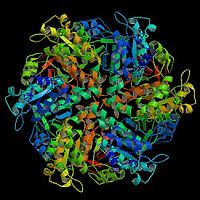
Photo from wikipedia
ABSTRACT Knowledge about precise numbers of specific molecules is necessary for understanding and verification of biological pathways. The RAD51 protein is central in the repair of DNA double-strand breaks (DSBs)… Click to show full abstract
ABSTRACT Knowledge about precise numbers of specific molecules is necessary for understanding and verification of biological pathways. The RAD51 protein is central in the repair of DNA double-strand breaks (DSBs) by homologous recombination repair and understanding its role in cellular pathways is crucial to design mechanistic DNA repair models. Here, we determined the number of RAD51 molecules in several human cell lines including primary fibroblasts. We showed that between 20000 to 100000 of RAD51 molecules are available per human cell that theoretically can be used for simultaneously loading at least 7 DSBs. Interestingly, the amount of RAD51 molecules does not significantly change after the induction of DNA damage using bleomycin or γ-irradiation in cells but an accumulation of RAD51 on the chromatin occurs. Furthermore, we generated an EGFP-RAD51 fusion under the control of HSV thymidine kinase promoter sequences yielding moderate protein expression levels comparable to endogenously expressed RAD51. Initial characterizations suggest that these low levels of ectopically expressed RAD51 are compatible with cell cycle progression of human cells. Hence, we provide parameters for the quantitative understanding and modeling of RAD51-involving processes.
Journal Title: Cell Cycle
Year Published: 2019
Link to full text (if available)
Share on Social Media: Sign Up to like & get
recommendations!